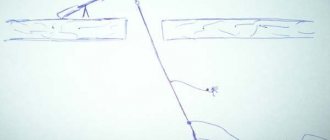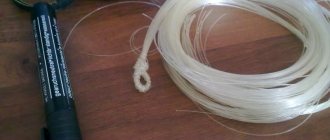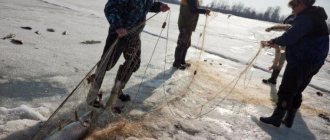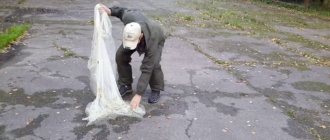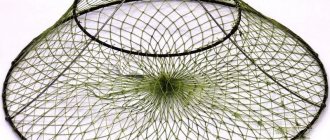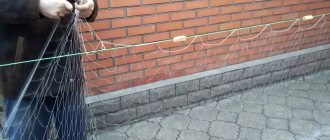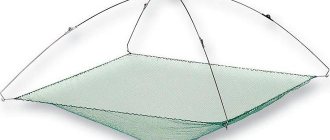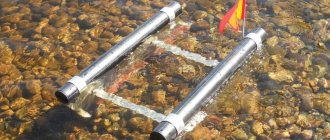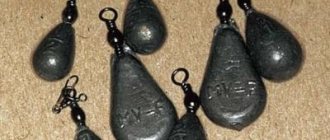The operating principle of a casting net, which is also called a cape, mantle or parachute, is simple. Such fishing gear is wound around the hand and then thrown to the selected point. Then the net is evenly lowered to the bottom, and then rises to the surface. All fish that were in the coverage area of the cape at the time of casting become prey for the angler.
If you observe an experienced fisherman, it seems that there is nothing difficult in casting such a fishing gear. In fact, it can take weeks and months to master the casting network. It is not for nothing that the Japanese treat the casting technique as an art and organize special competitions for masters of this craft.
At the same time, there is nothing overly complicated in handling such a net, and if desired, anyone can learn to fish with this tool in a very short time. There are two types of casting networks - Spanish and American. They differ both in design and casting technique.
American type networks with ring
American networks are equipped with rings of various diameters. Unlike Spanish women, the main cord in such models is attached not to the central part of the mesh, but to the strands, so the technique of working with them is significantly different. Their advantage is the ease of casting - the fisherman just needs to pick up and throw the net at the desired point. Also, American-type models provide more impressive catches than Spanish ones.
When the net is pulled out, the load is pulled to its center, while the entire structure is assembled into a single whole - into a kind of seine with a closed exit.
With a big ring
American nets with a large ring with a diameter of half a meter (Frisbee) can be easily thrown from a boat by throwing it away from you, while the parachute fully opens and completely sinks to the bottom. Models of this type are equipped with three rows of rings .
To cast such a net, you must:
- spread it out on the ground;
- release the middle ring, after which the large ring falls to the lower cord, and the third ring presses the net;
- put a cuff on your wrist;
- unwind the cord and send the net into the water in a motion similar to launching a frisbee.
No special skill or body rotation is required at the moment of the throw. The American net with a large ring is guaranteed to open in the air , while tangling of the lines during the casting process is excluded.
After each cast, the net must be cleared of branches and grass; this rule should not be forgotten even in the heat of excitement of fishing. Such careful attention to the fishing process will minimize the likelihood of unpleasant incidents when the net does not unfold as it should, and the throw is unsuccessful, and all potential prey is scared away in vain.
With small ring
The American casting network with a small ring resembles a Spanish woman. It is well suited for fishing in strong wind conditions, including at sea, when gusts make it difficult to throw a Frisbee net. A small ring presses the bag against the cord while pulling.
It must be borne in mind that the possibility of fishing with a net with a small ring of one diameter or another depends on the height of the fisherman:
- with a height of 1 m 45 cm, you can cast a net with a diameter of up to 3 m;
- height 1 m 70 cm allows you to throw nets with a diameter of 3.5 m;
- with a height of 1 m 80 cm and above, you can fish with four-meter nets.
This is how nets of this type differ from American ones, when fishing with which the diameter of the net used does not depend on height.
Casting fishing nets
Fishing with a cast net, also called a parachute net, a cape net, etc., is one of the traditional fishing methods, typical for Asian and South American countries. In our area it is not very common, although many, looking at the high catchability of the gear and its apparent simplicity, would like to learn how to work with it. Learning to properly use such a network is a rather painstaking and time-consuming process, but anyone can master this art if they wish.
The essence of fishing is as follows:
- the net is wound around the hand in a special way and thrown to the chosen place;
- there it opens, covering a certain area of water;
- its loaded part sinks to the bottom, forming a dome;
- a few seconds after casting, pulling the rope tied to the base, the angler tightens the loop;
- the fish that was under the net ends up in a kind of bag or pocket, and the net is raised to the surface.
Read Techniques for catching pike by trolling and rating the best wobblers
There are two main types of casting nets, differing in their design and technique of use - American and Spanish.
American and Spanish are the two main types of casting networks
American type casting network
An American casting net with a ring is a round net, along the outer edge of which a nylon cord with lead weights is threaded. There is a hole in the center of the circle with a ring attached.
The outer circumference of the net and the central ring are connected by slings. At the top, the lines are passed through the hole and attached to the ring. The ring is connected with a swivel to a traction cord, which is designed for casting and retrieving the tackle.
There are two types of American net - with a large and small ring.
Fishing with a casting net with a large ring
An American type casting net with a large ring is also called a Frisbee. It is usually equipped with three rows of rings. A casting net with a large double ring is also often used.
The American casting net with a large ring is the easiest to cast and retrieve. During flight, it is guaranteed to open without tangling the lines.
The easiest to cast and retrieve is the American casting net.
Small ring casting net
A casting net with a small ring resembles a Spanish flu. When pulled, the small ring tightens the net and presses it against the rope. This cape can be used in harsher conditions than a frisbee. It works well even in strong gusts of wind, when other networks cannot cope.
The choice of the possible diameter of an American casting net with a small ring is directly related to the height of the fisherman:
- if the fisherman’s height is up to 145 cm, then he will be able to use a net whose diameter does not exceed three meters;
- with a height of 170 cm, you can choose a net with a diameter of up to three and a half meters;
- height exceeding 180 cm allows you to work with any networks, including four-meter ones.
Spanish type casting network
The main differences between the design of the Spanish casting network and its American counterpart are as follows:
- lack of slings;
- attaching the traction cord directly to the central part of the network;
- the location of the weights at some distance from the edge of the network.
These differences affect the behavior of the network as a result of abandonment. When pulling a casting net without a ring, the sinkers, under the influence of their weight and the tension of the rope, gather towards the center. This covers the exit for fish, which fall into pockets formed around the perimeter.
The Spanish type casting net is characterized by the absence of slings
Spanish casting technique
Nets of this type are more difficult to cast, but their important advantage is that they are less likely to get snagged in areas with complex bottom topography.
When pulling a Spanish-type net, the loads converge towards the center of the circle due to their own gravity. To throw it, you need to:
- collect the main (traction) cord in your left hand with rings, check if there are any loops on it;
- take the net by the central part, shake it, stretching and straightening it;
- grab the top of the net with your right hand - about a third of its length - and collect it in one or two loops in your left hand;
- take the weight cord with your right and left hands at two points, spread your arms wide, stretching the net as much as possible;
- turn the body 180 degrees, and then straighten it, simultaneously throwing the net in an arc into the water.
To prevent the entire traction cord from flying into the water after being thrown, the loop at its end must either be secured to the left hand or attached to the belt. The second option is more reliable and completely eliminates the risk of losing gear.
Before going out onto a pond with a net, it is better to practice on land , choosing an area free from thickets of grass and bushes.
At the same time, you can master the technique of folding the net before casting, as well as the casting itself.
How to cast
First, I think it would be better to provide a universal casting method, and only then consider casting a Spanish net and with a ring separately. The entire casting stroke is shown in the diagram below. In the picture you can see a fisherman standing on the shore, but I recommend that you learn the intricacies of casting not on a pond, but on a lawn or field.
Of course, before casting a net in the field, you need to thoroughly clear the area of vegetation and various debris. Otherwise, you simply risk tearing the fishing device and will have nothing to practice on.
Stages of casting a net
It is necessary to collect the traction cord with rings in your left hand, and grab the tackle itself with an outstretched hand by the central part (if you are fishing with an American net, then you need to grab it by the sleeve). Now you need to lightly shake the net so that it stretches and straightens.
Then the upper part of the tackle is intercepted with the right hand (from a quarter to half of the net, depending on its radius) and assembled with one or two loops - also in the left hand. Next comes the turn of the cargo cord. He grabs two points with the same left hand and right, and the hands are placed wide enough so that the remaining free part of the net is stretched as much as possible.
Read Fishing for perch with a spinner and top best lures
The next stage is the actual casting itself. It is performed after two or three swinging movements or after one wide swing (in this case, the fisherman’s body turns almost 180°). The most important thing at this moment is the plane in which the tackle moves. The casting net, unfolding on the fly, should fly along the flattest trajectory and finally turn into a circle shortly before touching the water. The latter depends on the strength of the throw, the ability to measure which comes exclusively with training.
Another point where I disagree with foreign instructors: for the most part, they recommend that the loop at the end of the cord be wrapped around the left hand before casting. This works out well during training, but on a pond, when your hands are wet, the tackle can easily fly into the river or lake along with the cord. It is safer to attach the loop to your waist belt.
The described casting technique is not the only possible one. Almost every fisherman, with gaining experience, begins to modernize it, adjusting it to his individual characteristics and specific fishing conditions. For example, you can not collect the traction cord in rings on your hand, but leave it lying under your feet (provided that the shore is clear enough and the cord does not get caught on branches, roots, snags, etc.). The preparation time for casting is reduced, which increases the number of casts per fishing trip and, accordingly, the size of the catch.
Nets with a small radius (up to 1.7 m, for the tallest fishermen - up to 2 m) can be cast without collecting the upper part of the net into loops. Both hands, raised and spread as wide as possible, take the weight cord, the excess cord is collected into loops, 2-3 in each hand, so that the lower edge of the net does not reach the ground 30-40 cm, then the net is thrown, or rather thrown onto a body of water with a characteristic movement reminiscent of those used to throw a wide tablecloth on a table or a sheet on a bed.
I even happened to see how two people cast a casting net: two short teenage boys were catching, each of whom could hardly throw the tackle on their own - they took the net by the weight cord, standing on either side of it, stretched it wide in the horizontal plane and, They swung in unison and sent it into the pond.
Casting net fishing tactics
To always have a good catch, it is not enough to master the casting technique. The nuances of fishing with a casting net are no less than with a float rod or donka. For such fishing, areas of reservoirs with an open bottom, free of vegetation and snags, are suitable. It is inconvenient to use a casting net at great depths and fast currents, and it is better to avoid such points.
Achieving a good catch with this gear is not easy - only a person far from fishing would think that it is enough to throw it into a river or lake to get a good trophy, or even several. In reality, the chances of there being good fish in the netted area are slim.
The cape allows you to quickly and easily catch fry for use as live bait. A net with a small mesh, cast in places where small fish accumulate, will bring good catches with each throw.
To get a more substantial trophy, you need to comb with a cape the points where large fish can be held. Since fishing with a casting net among snags is impossible, it is necessary to check areas with uneven bottoms - holes and edges.
Fishing with bait
Good results when fishing with a cape can be achieved using bait . You can select several suitable areas on the reservoir and throw food into them for the fish, and then periodically check them with a net, each time adding a fresh portion of food. This tactic increases the chances of success significantly, because it eliminates the need to throw the net blindly at a point chosen at random.
But there is one difficulty - a very accurate throw is necessary, because a net with a diameter of several meters must accurately cover the baited area. To ensure that the cast hits the target exactly, you can mark the baited points with small buoys , which will serve as landmarks when casting. Without them, the chances of putting the tackle on a small feeding table are slim.
For beginners, the rules for handling the casting network often seem complicated, but, as in any business, skill is gained with practice. Many people disdain fishing with a net, but fishing with a cape can hardly be called unsportsmanlike. It involves an active search for fish and requires a lot of physical activity, and achieving a good catch is not easy, but always possible.
